PPC (pay-per-click) is a channel that’s often talked about in a vacuum:
Run ads. Gain traffic. Grow your business.
It sounds like a faucet you can turn on. All you have to do is twist the handle.
In reality, it’s more like finding a pair of matching shoes with your audience.

PPC can be an effective channel for driving organizational growth, but there are lots of factors to think through before you pick out a new pair of brown oxfords.
Is PPC a good marketing tactic for your business?
Jumping into PPC without asking questions can lead you to throwing thousands of precious dollars away into the dumpster fire of unchecked assumptions.
Even if all signs point to growth, establishing a fixed period where you take your PPC for a test drive is a crucial step when determining whether it’s worth investing in a scalable program.
Here is the decision tree we use when assessing if PPC is the right tactic:
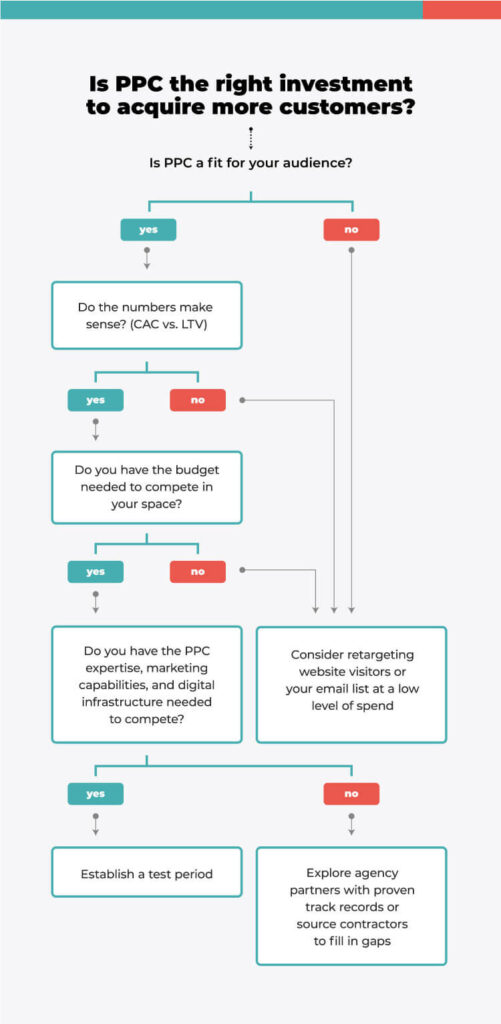
Table of Contents
- Is PPC a Fit for Your Audience?
- Do the Numbers Make Sense?
- Do you have the budget needed to compete in your space?
- Do you have the expertise, marketing capabilities, and digital infrastructure to compete?
- Offers
- Ad Creative
- Landing Pages
- Email Nurture Tracks
- Tracking Infrastructure
- PPC Strategy, Set Up, Monitoring, and Optimization
- Establishing a Test Period
1) Is PPC a Fit for Your Audience?
The first gate to slalom when determining whether you should invest in PPC is a close look at how your audience interacts with what you’re selling.
There are a few different ways to analyze this:
- Audience behavior (buyer’s journey)
- Audience type (targeting parameters)
- Audience intent (keywords)
Audience Behavior
 A well-constructed buyer’s journey defines the key interactions that turn a stranger into a customer – usually broken down by different stages.
A well-constructed buyer’s journey defines the key interactions that turn a stranger into a customer – usually broken down by different stages.
Building a buyer’s journey is an exercise in empathy. And one that can be data-backed and accurate with the right research.
The buyer’s journey is an important consideration when evaluating whether PPC can drive more customers for you. Here’s why:
- If your audience only chooses solutions like yours through close personal connections and networking, PPC may play a minor or negligent role in new customer acquisition (think high-touch event planning or expensive, highly custom B2B solutions)
- If your customers make quick, impulsive decisions with a relatively short sales cycle, PPC may be an excellent vehicle to drive new purchases (think eCommerce products like clothing or household goods)
If you don’t have a clear sense of what stages your buyers go through before a purchase, the easiest way to learn is to talk to them.
Call a few different types of customers, ask them how they found you, and extrapolate some thrifty insights. Or invest in some validated research that can shape your marketing strategy.
Key Question to Ask: Will PPC move potential customers through the top, middle, or bottom of the buyer’s journey towards a purchase?
Audience Type
If your audience is Fortune 500 CEOs, it’s going to be tough to reach them through PPC.
On the other hand, if you’re selling leggings to high-income women who enjoy hunting, PPC might be an excellent channel to acquire new customers and move more product.
(These are both audiences we’ve been asked to target via PPC).
Different platforms offer different targeting parameters, but the general rule of thumb is:
You need to have an audience that’s large enough and accessible enough for an ad network to match them with your ads.
When running PPC on platforms like LinkedIn or Facebook, you can select different demographic and psychographic factors to hone in on the folks you want your ads shown to.
You can find an epic infographic of all of Facebook’s targeting options here, and a cheat for LinkedIn ads here.
Key Question to Ask: Can this audience be reached on ad platforms like LinkedIn, Facebook, and Instagram?
Audience Intent
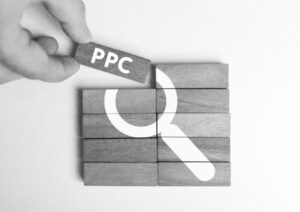 When evaluating whether search-based PPC through Google is worth investing in, you need to take a look at audience intent.
When evaluating whether search-based PPC through Google is worth investing in, you need to take a look at audience intent.
The first step is to unearth what search queries (keywords) map to each phase of the buyer’s journey for your audience. Then, look at the volume, level of competition, and cost-per-click of those keywords.
We’ll get into the economics of how much you should spend on a click down below (see the section on LTV + CAC) but for now, we’re evaluating whether the keyword volumes are large enough (and the competition is tame enough) to make PPC on Google an interesting channel.
This gets particularly tough when you’re looking at category creation.
If no one has heard of what you’re selling yet, you can’t expect leads to come pouring in overnight from existing search queries.
Understanding the Range of Keyword Intent
Marketers can quickly jump to bottom-of-the-funnel (BOF) keywords being the most straightforward:
Someone wants what you sell, and they know how to search for it.
But not all bottom-of-the-funnel (or ‘decision’ stage) keywords are created equal.
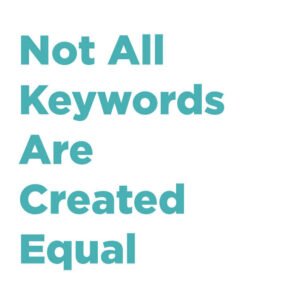 Take the phrase “contact center employee training software.” If you sell contact center employee training software, that may seem like the gold standard for BOF keywords.
Take the phrase “contact center employee training software.” If you sell contact center employee training software, that may seem like the gold standard for BOF keywords.
The ‘decision’ stage assumption is: someone typing that in knows what to look for and is choosing between providers.
However, to categorize that query properly, we have to peel back the layers of possible intent:
- They could be researching whether this exists – in which case, they’re a TOF lead (in the ‘Awareness’ stage)
- They could be deciding whether this is worth investing in – in which case, they’re a MOF lead (in the ‘Consideration’ stage)
- They could be an employee looking for the name of a software their boss mentioned in the last staff meeting – in which case, they’re not a lead at all
It’s worth taking a very close look at what keywords you’re focusing on, and the possible range of intent each one could include.
Drawing out hypotheticals can be helpful if you’re considering a PPC test for your business. And tighten language to clarify intent wherever you can.
How to Balance Clear vs. Creative
There’s a tricky line between engaging, creative messaging vs. qualifying messaging that makes intent crystal clear.
The clearest, intent-filtering ad copy for the keyword “contact center employee training software” is probably something like this:
“If you click on this ad, we’ll take you to a landing page where we’ll try to sell you on contact center employee training software that costs $xx,xxx per year and trains your call center employees to provide better customer service through a six month online training program.”
…Doesn’t roll off the tongue. Doesn’t capture your attention.
Doesn’t quite fit the bill for creative messaging that both (1) matches the searcher’s intent and (2) is intriguing enough to earn a click.

Ultimately, it’s hard to completely predict where intent won’t quite align with the ads, offers, and landing pages you produce in a PPC campaign.
That’s why a PPC test period with a marketing partner with a proven track record is important, so they can adapt and adjust to filter out the wrong types of leads.
The Key Question to Ask: Is there search volume with the right intent around our solutions, and can we keep up with the competition?
2) Do the numbers make sense?
If the audience considerations all check out – or at least don’t disqualify a PPC test period – the next area to look at is anticipated ROI.
There are a few key metrics that help assess whether PPC will be a viable channel for your business. The first is:
- Cost-per-click (CPC): Which can be estimated with potential audience targeting parameters, keywords, competitors, and channels in mind.
Cost-per-click is simply how much you pay for each click you earn on an ad platform, and the costs can range based on the competition.
>> Curious how ad bidding works? Learn more about it here <<
Then, two more calculations that can help you assess how much you should spend to acquire a new customer:
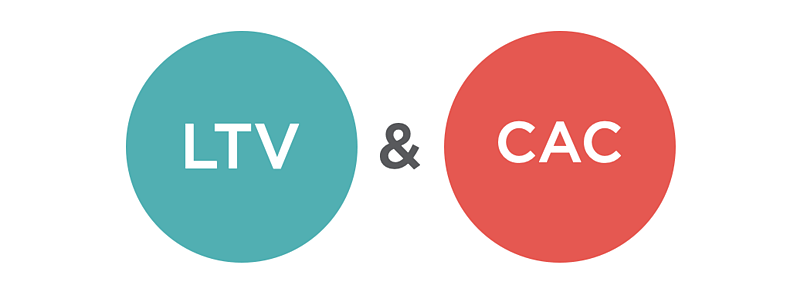
- Lifetime Value of a Customer (LTV)
- Customer Acquisition Cost (CAC)
Here’s how to use LTV and CAC to determine how much you should spend to acquire a customer:
Keep in mind that CAC will go up when you start spending money on PPC.
If you’ve calculated how much to spend to acquire a customer, you can compare that number against anticipated PPC metrics.
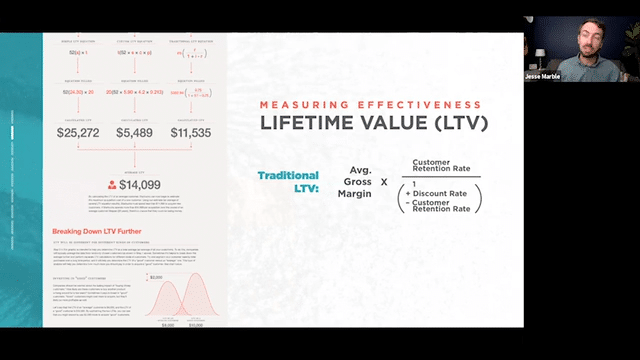
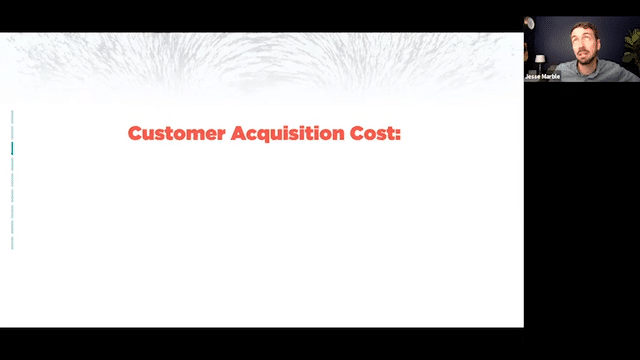
Comparing CPC against LTV & CAC
If you look at an anticipated cost-per-click (CPC), you can start to put together the puzzle of what level of ad spend it will take to drive new customers.
>> Not sure how to anticipate what your cost-per-click will look like? We’re happy to help <<
Say your CPC is estimated to be $1. The next step is to figure out how many of those clicks will turn (or ‘convert’) into leads.
For this, we need to estimate a conversion rate.
You can find all sorts of helpful benchmarks to understand what conversion rate to anticipate within your industry and market:
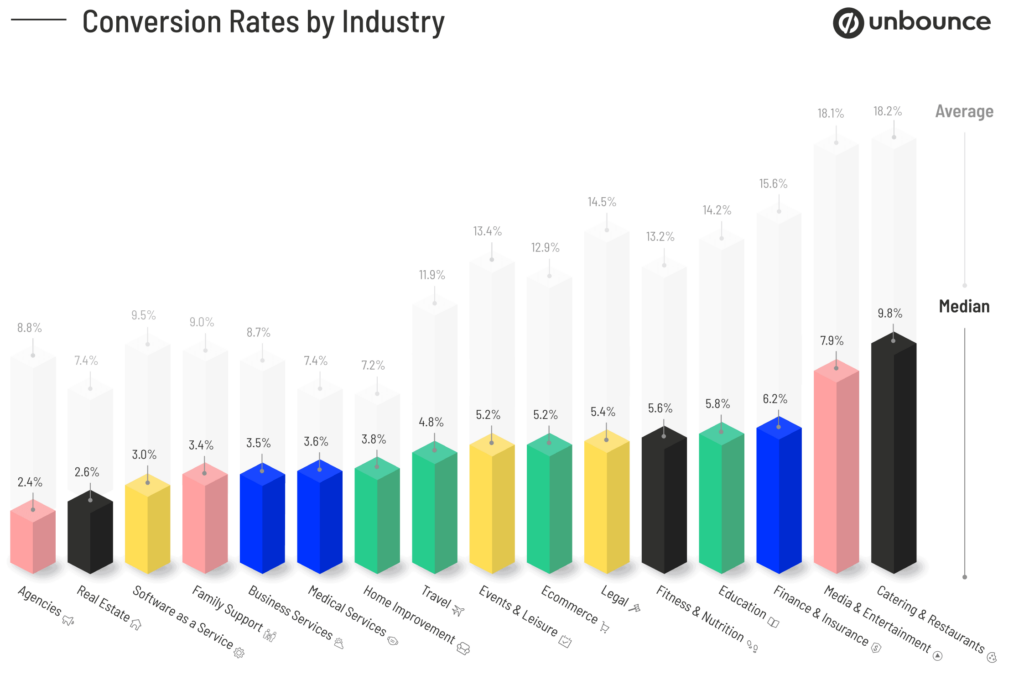
Source: Unbounce’s 2021 Conversion Benchmark Report
If your clicks cost $1 each, and your conversion rate is 1%, you need $100 in spend to generate 1 new lead.
If your budget is $1000 per month, you can expect to generate 10 new leads per month.
Then your cost-per-lead (CPL) is $100.
How to Decide on PPC Numbers for a B2B Business
Assuming each lead that comes through the door is qualified, the next step is to factor in your sales team’s close rate.
Say you close 50% of new leads. With a budget of $1,000 per month, you’ll close 5 new customers.
Your PPC cost-per-acquisition (CAC) is $200 per new customer.
If your LTV on each customer is $3,000, then PPC is worth testing.
How to Decide on PPC Numbers for an eCommerce Business
If you’re running an eCommerce business, then you can ignore the sales team close rate, and instead just look at conversion rate – since customers can guide themselves through a checkout process.
The same rule applies – if your LTV is significantly higher than your CAC on PPC, then you should consider investing in a test period.
PPC Is Not an Exact Science
PPC is not an exact science, and – while estimates can be a helpful starting point – testing in real time with actual spend may produce different results.
You may see a lower frequency of clicks, and struggle to spend the entirety of your budget. Or, you may experience an influx of unqualified leads clicking through and not converting.
The value of a test period is that it provides a real-time evaluation of both the predictable and unpredictable factors of PPC.
Make sure you choose a qualified partner to guide you through the process, so that you have the highest chance possible of building a successful program – and don’t waste any money through poor implementation.
3. Do you have the budget needed to compete in your space?
There are objective ways to measure whether you have the budget needed to compete in your space, but for our purpose of evaluating whether or not you should test PPC, a general gut check is sufficient.
How crowded is the space you’re in, and what differentiating factors can you highlight?
The Importance of Brand Awareness
If you’re a new provider just entering a crowded market, it may be a while before you see any conversions from a PPC channel.
In most cases, especially in B2B and with high-priced products, a general level of what we call brand awareness (your audience is aware that you exist) is required before you’ll get a level of engagement that turns into a lead.

That’s okay. That’s part of the process. But it is an adjustment if you’re expecting to turn on PPC and see a high ROI right away in the form of new customers.
In that situation, you’ll need the budget to generate brand awareness in the market, which typically means outspending your competitors on each PPC channel – and seeing a lower ROI that gradually trends upwards over time.
Not sure how to evaluate your competitors? You can use tools like SpyFu to get an estimated level of PPC spend.
That’s not always the case with eCommerce and lower threshold conversions.
If you need a pair of cheap winter gloves (let’s say under $10) and an ad pops up at the right time with the right message, you’re less likely to get hung up on whether it’s a brand you’ve heard of or not.
Contrast that with a $75k services agreement with a marketing agency. You’ll want to know a lot about them before you’ll ever consider signing up through an ad.
The Power of Differentiation
If you sell toothbrushes and yours (also) helps remove plaque, you may have a tough time standing out in a market of crowded toothbrush ads.
A key factor in PPC is positioning:
 Do you have compelling enough differentiating factors to earn a click in a head-to-head moment with a competitor’s ad that appears right next to yours?
Do you have compelling enough differentiating factors to earn a click in a head-to-head moment with a competitor’s ad that appears right next to yours?
If you provide the same functional benefits as a well-known competitor, and they’re investing heavily in PPC, you may have more luck by allocating your marketing budget elsewhere.
While strong creative and well-timed ads can help you compete, they won’t earn you more traction than a competitor who’s already saturated the market with brand awareness and offers the same benefits as your product or service.
The most important factor is what your audience can perceive quickly – with the limited information and context they arrive with.
If you can provide a momentary zag where your competitors zig – addressing a known pain point in a unique way – you may be able to earn some clicks and intrigue, then work towards a landing page that reliably converts (turning ad spend into new leads and customers).
Key Question: Do you have the budget and unique positioning needed to compete in your space?
4. Do you have the expertise, marketing capabilities, and digital infrastructure to compete?
To adequately compete in a crowded PPC market, you need more than just a few ad designs and a website to point visitors to.
Here’s a quick look at the different elements involved in creating and scaling a successful PPC program:
Offers
Just advertising functional benefits is a starting point and go-to advertising tactic for most businesses. In order to compete and earn clicks over your competitors, you may need to unpack other aspects of what your potential customers look for and value in your market.
If you’re following inbound methodology, this means creating helpful content and offers that can solve tangible pain points at each stage of the funnel.

If you’re promoting eCommerce products, creating urgency through discounts or promotional windows can help motivate viewers to take action.
Regardless of your approach, each ‘offer’ can take a period of ideation & strategy, writing, design, and sometimes development (in the case of interactive online resources like calculators or web apps).
Multiply the number of offers by each stage of the funnel you want to approach users through via PPC, and you’re laying the foundation for adequate testing.
Making sure you’re resourced well enough to produce new offers to test in the market – and edit existing ones based on incoming data – is crucial to building a successful, scalable PPC program.
Ad Creative
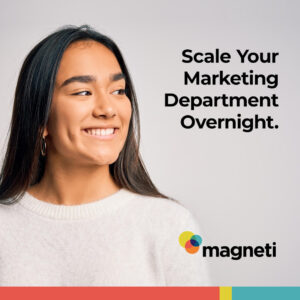 No matter what channels you choose to advertise on, you’ll need ads.
No matter what channels you choose to advertise on, you’ll need ads.
Different sizes and dimensions are required by different platforms, and you’ll want to create a variety of ads to test against each other to increase your chances of finding a successful mix.
Ads require a mix of design expertise, platform knowledge, and effective copywriting. Integrate these skillsets, and you have a recipe for successful ad creation.
Landing Pages
Landing pages are the marketing term for web pages built with conversion in mind – and where competitive PPC campaigns send users once they’ve clicked on an ad.
Rather than directing users to your homepage or a generic product page – which likely is built for a variety of intents and audiences at all stages of the funnel – sending users to a ‘landing page’ that matches the intent articulated in the ad creative helps provide a cohesive and intuitive journey for a stranger to get acquainted with what you have to sell.
The logic here is simple: when a page is tailored for the intent of a visitor and matches what they came for, the likelihood of seeing a conversion is higher.
The rise of personalization is largely a data-driven movement in marketing, and the more custom and tailored you can deliver marketing experiences (while still delivering them at scale) tends to improve your conversion rate.
Aligning intent from ad creative → landing page → conversion opportunity signals to a visitor that they’re in the right place and removes the friction between a user and conversion.
Less friction means more conversions.
The ability to efficiently build and optimize conversion-focused web pages can be the difference between experiencing a lot of expensive clicks and seeing a lot of ROI-driving conversions.
It’s also important to make sure your conversion tool – whether it’s an eCommerce checkout process or a simple web form – feeds data into the right places so that your hard-earned leads don’t get missed or lost.
Email Nurture Tracks
If your PPC campaigns aren’t just focused on winning competitive BOF leads who are ready to convert, and also attracts TOF or MOF leads, the next question to answer is this:
What happens after they convert and enter your marketing ecosystem?
This is where PPC can overlap with a lot of your other marketing initiatives.
New content creation that fits the stage of the funnel can help move incoming leads to the next stage.
The most common (and arguably the most effective) way to move new leads through the funnel is by pairing your PPC efforts with email nurturing campaigns.
These can be automated through any major email provider (HubSpot, MailChimp, Constant Contact, Salesforce, etc.) – meaning, scalable – so that you don’t have to press send every time a new lead converts through PPC.
Email nurture tracks typically consist of 3+ emails spread out over a few days or weeks, and are built to entice TOF or MOF leads to continue to buy into your organization with additional conversion points.
These ‘conversion points’ can be anything from content offers to case studies to price comparisons. As we near the bottom of the funnel, the right touchpoints typically shift to purchase buttons or an offer to schedule time with a sales rep.
To build email nurture tracks, you need:
- At least one email template
- Copywriting expertise
- Design support
- Some light development expertise
- Email platform knowledge to put the right automation logic in place and to move new leads into the right email lists
Tracking Infrastructure
Transparency is crucial to successful PPC. Being able to track what works from ads to landing pages to conversions to email nurturing is the key to building a justifiable, ROI-delivering PPC program.
Seeing where users are dropping off in the process shines a light on where you can test and optimize.
If you experience lots of clicks through to a landing page, but you don’t see any conversions, you can put your landing page under a microscope and find elements to change and optimize.
Or if you’re seeing one set of ads wildly outperform another, you know where to reallocate your budget to see better results.
Setting up an effective ad tracking infrastructure typically requires ad platform expertise, email platform knowledge, experience with setting up events and UTMs in Google Analytics, and CMS development knowledge.
While tracking systems exist and can effectively inform your PPC efforts, they’re rarely perfect. Ad platforms keep their algorithms behind closed doors, and handoffs between platforms aren’t always seamless.
Creating a feedback loop on PPC lead quality and closed opportunities with your marketing and sales teams can help guarantee that you have the right inputs to make strategic decisions.
PPC Strategy, Set Up, Monitoring, and Optimization
In addition to the individual assets needed to build and scale an effective PPC program, you also need access to PPC expertise that can help guide:
- Which platforms you should advertise on
- How much budget to initially allocate to each channel
- Channel set up and early optimizations
- Keyword discovery and analysis
- Audience targeting and creation
- Utilization of assets like existing email lists and website traffic
- Guidance on ad creative for each platform
- Ongoing maintenance and optimizations
- Reallocation of budget based on performance
- Consistent reporting and strategic recommendations to improve ROI
Key Question: Do you have the resources and expertise needed to compete?
* If you don’t have access to PPC expertise or any of the digital resources above, consider finding a partner agency with a killer track record.
If you answered ‘yes’ to all of the questions above, the next step is to set a test period.
Establishing a Test Period
You wouldn’t buy a car without test driving it, and the same is true for a PPC program. Before you go all-in on PPC as a growth lever for your business, it’s worth taking it for a spin and seeing how it performs with an established test period.
What does a good test period look like?
When you’re setting a test period, there are a couple of areas to commit to:
- A target level of spend (or a set budget)
- A set period of time
Target Level of Spend
This is a balancing act between what level of spend you need to be competitive within the market and what level of spend you’re willing to invest in discovering the viability of PPC (and therefore without guaranteeing results).
Typically our PPC experts will establish a minimum monthly spend based on keyword bids, audience targeting parameters, and estimated competitor budgets.
From there, we’ll have a conversation on PPC within the context of a marketing budget and determine that amount is viable.

This is where LTV and CAC calculations can come in handy.
It’s important to note that in pay-per-click, you can set a ceiling on how much you spend, but ultimately you can under-spend if ad tests aren’t performing (and therefore aren’t getting clicks).
In a successful test period, your budget will be spent in full and the incoming ROI will justify maintaining that level of spend or increasing it.
In an unsuccessful test, your budget may be underspent from a lack of audience engagement, or the quality of leads and program revenue may not justify a continued investment.
Set Time Frame
It’s important to establish a minimum time frame for testing and stick to it.
Your time frame should account for an initial period of set up, time for testing and iteration, lead quality evaluation, and should include the length of at least a few sales cycles so you can accurately report revenue tied to PPC efforts.
Although it can vary based on available budget and market considerations, we typically recommend a minimum test period of 6 months, and will often run tests up to 12 months.
That helps:
- Achieve a thorough level of testing across audiences, offers, ads, and landing pages
- Avoid skewed results based on seasonality
- Outstretch momentary shifts in the marketplace
- Run the length of at least one full sales cycle
- Outlast any significant short-term changes in competitor PPC investments
Building a Test Period Strategy
With the budget and time frame established, the next step is to map out a PPC strategy. Questions to answer here:
- How many platforms do we plan to use?
- How many campaigns do we plan to create and run?
- What stage of the funnel should each campaign target?
- What platforms do we need to set up? These often include:
- Google Ads
- Facebook Ads account
- Google Business Profile (formerly called Google My Business or “GMB”)
- Google Analytics
- Conversion Tracking
Typically, during a test period, the best way to launch PPC is to start at the bottom of the funnel, and work your way up based on available resources to provide lead nurturing touchpoints.
If You Aren’t Seeing PPC Results, What Can You Change?
If early testing isn’t yielding results, here are some areas to address:
1. The Number of Campaigns
One common problem that can occur is that a budget is getting spread too thinly between too many initiatives or it’s not being spread widely enough to serve as a helpful test.
Adding or removing the number of campaigns can help ensure this period yields insightful results.
2. Allocation of Budget
If a certain campaign is outperforming the others, shifting budget away from struggling campaigns and fueling the momentum of the ones performing can help you maximize results and minimize losses.
The same applies for channels: if you’re seeing conversions occur in Google Ads campaigns, but Facebook isn’t performing well, moving a portion of the Facebook budget over to Google can improve overall metrics and still allow you test both channels.
3. Audience Targeting
On channels like Facebook, Instagram, and LinkedIn, you can test and change the demographic and psychographic targeting options to further hone in on your audience, or use an email list to create “lookalike audiences” based on a platform-specific algorithm.
With Google, you can add or remove keyword groups to match with the right audience intent.
With all of these channels, you can switch from trying to reach brand new audiences to retargeting people who have visited your website.
4. The Offer
Swapping out offers is a great way to alter the results of your PPC test. If one offer isn’t working, you can swap out to another or adjust to try and target a segment of your audience that’s at a different stage of the funnel.
5. Ad Creative & Messaging
If you’re confident in audience parameters, the breakdown may lie in the ads. Platforms make it easy to test different versions of messaging and ad designs next to each other so you can find commonalities in what’s working and remove what’s not.
6. Landing Page Creative & Messaging
If you’re seeing lots of clicks on ads, but no conversions, the problem may lie in the landing page design and messaging. Making calls-to-action clear, adjusting what messages appear where, and changing the overall page experience are all ways to address a high-click, low-converting campaign.
7. Nurture Emails & Subsequent Marketing Touchpoints
If PPC leads are qualified but they aren’t turning into customers, creating and optimizing automated email nurture tracks can help remind leads who you are and what you can offer them.
If you embark on a PPC test with a trusted agency partner, here’s how to measure success.
Need a PPC partner to test with? We have a habit of building PPC programs that scale and thrive.

